Think about it.
Your jackets spend more time in your closet than they do on your shoulders.
And what are they resting on – for days if not months & years?
Thin, cheap, wire hangers that are NOTHING like your shoulders?
The fact is wire hangers cause puckered shoulders, re-shape hand-padded expensive jacket shoulder negatively, and ultimately ruin your clothes right in your own closet.
Don’t ruin great clothes with cheap hangers.
One size doesn’t fit all when it comes to your clothes, and the same is true when it comes to your hangers.
This article provides detail guidance on the new standards for sizing the perfect wooden garment hanger.
“Alan Katzman of Alan Couture, a bespoke clothier in Manhattan whose suits range from $5,000 to $30,000… calls quality hangers a must. Unlike the dreaded wire versions, hangers with wide shoulders and a broader overall design prolong a garment’s life by preventing sagging or stretching.”Ordinary hangers just hang your clothes. They do nothing more. Examples are free wooden hangers, wire and cardboard hangers from dry cleaners, and plastic hangers, and they can be found in many ordinary closets.
No Wire Hangers!
Nov 16, 2008, Wall Street Journal
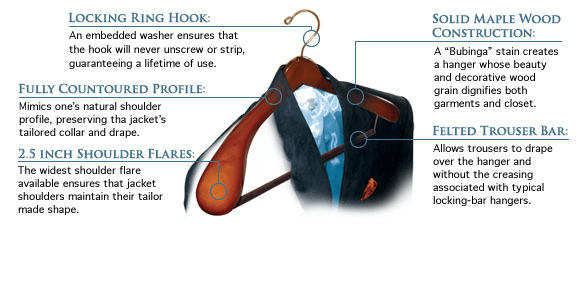 Properly
made wooden hangers, on the other hand, are deliberately crafted from
premium woods to protect and extend the life of your clothing.
Properly
made wooden hangers, on the other hand, are deliberately crafted from
premium woods to protect and extend the life of your clothing. They provide opulent shoulder support, are correctly sized, and do not damage your clothes.
Over the life of your wardrobe, they can save you thousands of dollars in ruined garments (think about the number of times you’ve thrown away a shirt because of shoulder dimples or a suit because it became limp).
Let’s Talk Hanger Styles
The style of a hanger is the first thing to consider when selecting your hanger. Different hangers are designed for different purposes.
I make seven different styles designed just for men, plus another nine totally different styles for women. Men and women have dramatically different wardrobes, and the same is true for their hangers. A premium wooden hanger is, by design, gender specific.
The following is a list and brief description of different styles of men’s hangers and their use:
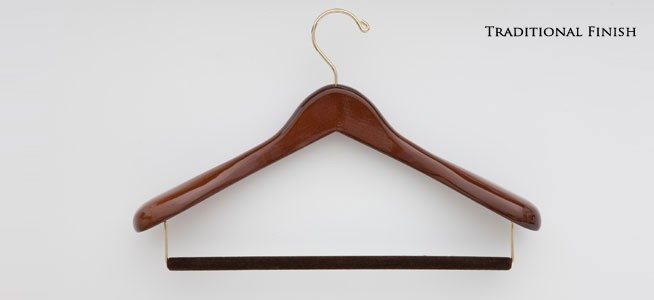 Suit Hangers – a proper suit hanger
is used to hang matching jacket and trouser sets. The hanger should
offer opulent support to protect the delicate, tailored shoulder
construction and drape. They should be fully contoured and have a large
shoulder flare to optimize shoulder support. The trouser bar should be
flocked or felted in order to prevent the creasing that ordinary locking
bars can cause. The width is also important; in order to offer optimal
support, the suit hanger should extend up to but not beyond the point
where the shoulder meets the sleeve. This is especially important for
gentlemen with broad shoulders, as the weight of a large jacket
distributed on a skinny hanger will almost immediately destroy its
drape.
Suit Hangers – a proper suit hanger
is used to hang matching jacket and trouser sets. The hanger should
offer opulent support to protect the delicate, tailored shoulder
construction and drape. They should be fully contoured and have a large
shoulder flare to optimize shoulder support. The trouser bar should be
flocked or felted in order to prevent the creasing that ordinary locking
bars can cause. The width is also important; in order to offer optimal
support, the suit hanger should extend up to but not beyond the point
where the shoulder meets the sleeve. This is especially important for
gentlemen with broad shoulders, as the weight of a large jacket
distributed on a skinny hanger will almost immediately destroy its
drape.
- Jacket Hangers – A proper jacket hanger should contain all of the same characteristics of a suit hanger (detailed above) but without the trouser bar. Jacket hangers are used for sports coats that would not have matching trousers and guest coat closets.
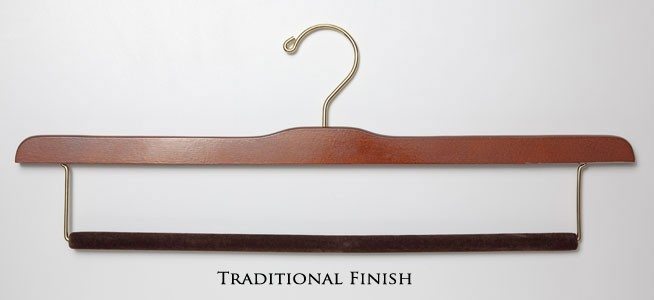 Trouser Hangers – Trouser hangers
are an essential part of any well-appointed closet and are only used
for hanging trousers. Because of their specific application, they save
room relative to using old suit hangers. The most important criteria for
a wooden trouser hanger is whether it creases trousers. Locking bars,
although very common, actually damage the fabric of most trousers over
time and lead to creasing across the thigh, which can result in
embarrassing creases across the trousers when pulled out of the closet.
Trouser hangers are not contoured.
Trouser Hangers – Trouser hangers
are an essential part of any well-appointed closet and are only used
for hanging trousers. Because of their specific application, they save
room relative to using old suit hangers. The most important criteria for
a wooden trouser hanger is whether it creases trousers. Locking bars,
although very common, actually damage the fabric of most trousers over
time and lead to creasing across the thigh, which can result in
embarrassing creases across the trousers when pulled out of the closet.
Trouser hangers are not contoured.
- Locking Bars – A wooden bar locks the trousers between a metal wire. This mechanism is BAD, as they cause creasing across trousers and can damage premium wools (like Super 100′s). This is the most common and inexpensive type of trouser bar and can be found on most department store hangers.
- Felted Trouser Bar – The trouser bar is flocked or felted with a material whose texture “grips” trousers. Trousers drape over the bar and no pressure is applied (as with a locking bar), thereby preventing creasing. This is the BEST style and can only be found on premium wooden suit hangers.
- Clamping Trouser Bar – two planks of wood with felted interiors clamp trousers at their cuff and hang them vertically upside. This style is popular but demands a lot of vertical closet space. The weight of the trousers “pull” wrinkles out over time as the trousers hang. Can be found on premium wooden suit hangers, although they increase their cost significantly.
- Clip Hangers – use two independent clips to secure the trouser. These are generally discouraged for finer wool, cotton, or linen trousers because the force of the clip can damage the fabric. However, they are totally acceptable for hanging denim jeans or shorts.
- Shirt Hangers – a man’s shirt hanger should extend all the way to the edge of the shoulder. If a shirt hanger is too narrow (width), puckering or dimpling occurs. It should also be thick enough to offer support, but not so thick that closet space is unnecessarily consumed. Premium wooden shirt hangers are especially important for loosely-knit fabrics, such as cotton and cashmere shirts. Shirt hangers are not contoured.
- Sweater Han
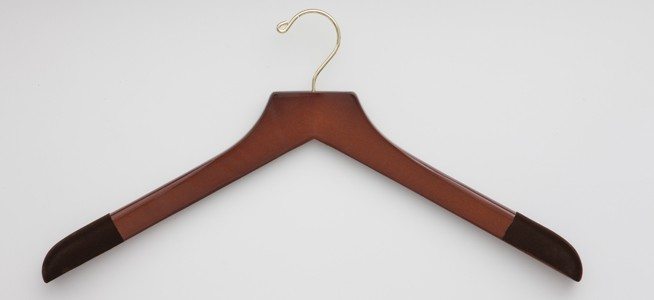 ger
– Most people fold their sweaters — not because folding is necessarily
better, but because most ordinary hangers are very quick to destroy
sweaters. This is why The Hanger Project developed a sweater
specifically sweaters and soft knits. The moderate shoulder flare, which
is flocked to help grip the garment, controls the sweater and prevents
it from sliding down the hanger. This prevents both stretching and
shoulder puckering.
ger
– Most people fold their sweaters — not because folding is necessarily
better, but because most ordinary hangers are very quick to destroy
sweaters. This is why The Hanger Project developed a sweater
specifically sweaters and soft knits. The moderate shoulder flare, which
is flocked to help grip the garment, controls the sweater and prevents
it from sliding down the hanger. This prevents both stretching and
shoulder puckering.
The width of a hanger is the most overlooked but critical characteristic of a proper hanger.
One size doesn’t fit all when it comes to your clothing, and the same should be true when it comes to your hangers. Considering that your garments will spend more time in your closet over the lifetime than on your shoulders, it is easy to understand why this characteristic is so important.
The sizing principle is the same for both suits and shirts: the hanger should extend all the way to–but not beyond–the point where the shoulder meets the sleeve. The most accurate method of sizing your hanger is to measure directly across the back (the point-to-point measurement).
My company makes suit hangers in four widths: 15.5″, 17.0″, 18.5″, and 20.0″. A 20.0″ suit hanger is an exceptionally large suit hanger perfect for professional athletes and other gentlemen with particularly broad shoulders, while the smaller hanger is aimed for the smaller man who is tired of over sized hangers blowing out the shoulders on his expensive suit jackets.
As for wooden shirt hangers, you’ll often find them in lengths of 17.0″, 19.0″, and 21.0″. Choose the size that is closest to the width of your shirt. It is okay for your shirt hanger to extend slightly beyond the shoulder. With the right luxury shirt hanger, you will be able to almost eliminate the annoying shirt puckering that often plagues closets.
Hanger Girth
The GIRTH of a hanger, or it’s thickness, is particularly important at its ends. I make a suit hanger with a 2.5″ Shoulder Flares distributes the weight of a jacket over a surface area 5x larger than average. This, in turn, ensures that the drape of the jacket is protected.
I hope you found this article useful – if you have any wisdom or stories to share I’d love to hear from you in the comments below.
More info:
http://mansuits123.blogspot.com/2013/05/why-are-flannel- trousers-so-hard-to-buy.html


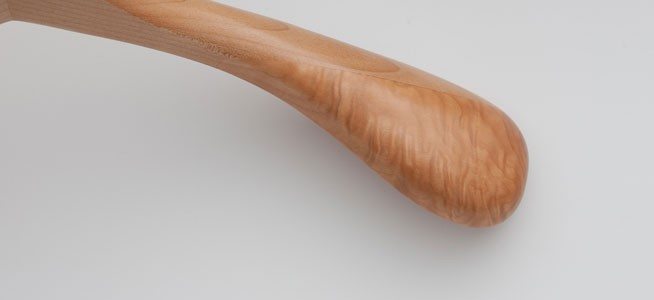
No comments:
Post a Comment